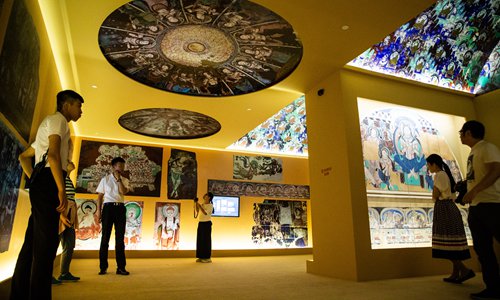Exhibition showcases the Silk Road's impact on cultural diversity in Xinjiang

Visitors explore the Exquisite Xinjiang Cultural Relics exhibition at Beijing's National Museum of China on Tuesday. (Global Times/Li Hao)
An exhibition featured 191 exquisite cultural relics unearthed in Northwest China's Xinjiang Uyghur Autonomous Region kicked off on Tuesday at the National Museum of China in Beijing.
Including metal works, carvings, textiles and pottery spanning from the Neolithic period to the Yuan Dynasty (1279-1368), the relics on display provide a glimpse into how the ancient Silk Road contributed to the diversity of culture in the region.
The Exquisite Xinjiang Cultural Relics exhibition, jointly held by the National Museum of China and the Xinjiang Uyghur Autonomous Region Museum, is divided into three sections: The Early Silk Road, The Glorious Era of the Silk Road and Buddhism's Influence along the Silk Road.
The Xinjiang Uygur Autonomous Region Museum boasts a collection of relics that number in the tens of thousands, among which 288 are national first-grade level. Highlights of the exhibition include three Tang Dynasty (618-907) paintings of Fuxi and Nüwa and Wooden Burial Figure of a Woman in Silk Garments, both of which appeared on the popular TV program National Treasure Season Two back in January.
Fuxi and Nüwa are two figures from Chinese mythology that are considered the ancestors of humankind. In the paintings, the two have human upper bodies and a snake's tail for their lower halves. With their tails entwining each other, Fuxi is on the right, holding a set square, while Nüwa is on the left, holding a geometric compass. The sun is painting above their heads in the middle of the painting, while the moon sits below where their tails intersect.
According to legend, Fuxi taught humans how to hunt, fish and make weapons, while Nüwa introduced marriage. The square and the compass they are holding are tools for production but also represent order in society.
The Wooden Burial Figure of a Woman in Silk Garments is special in that its arms were made of paper so they could be arranged into different poses, while the clothing the figure wears provides important information into the fashions of the Tang Dynasty.
To present the Buddhism cultural relics found in grottos in Xinjiang, mainly large statues and murals, replicas and videos are on display in the exhibition hall for the third section.
The Xinjiang region became a part of Chinese territory during the Han Dynasty (206BC-AD220). Cultural communication intensified when Zhang Qian, the envoy of the Emperor Wu of Han, traveled westward from Chang'an, capital of the Han Dynasty, and helped usher in the establishment of the Silk Road.
The exhibition contains official documents that show the connection the Han central government had with local executive branches, such as seals used by local government officials and records detailing money spent on horse feed at post stations.
A drawing unearthed from a tomb in Xinjiang's Tulufan depicts the tomb owner's daily life and reveals how similar people's clothes and furniture were to people living on the central plains, the middle and lower reaches of the Yellow River in ancient China.
A pillow for a local noble man made of brocade produced in the central plains is also on display. Using brocade to cover the body of the deceased was common in the central plains and indicates that burial customs in Xinjiang were influenced by the culture communication along the Silk Road.
The exhibition will last until September 9.
- Children's books boost Sino-Western cultural exchanges at int'l book fair
- Foreign envoys praise prosperous Xinjiang at conference
- Feature: Cuban boxing champion crosses ocean to foster talents in Xinjiang
- Xinhua News | China's Xinjiang posts robust foreign trade growth in Jan-Feb
- China's Xinjiang posts robust foreign trade growth in Jan-Feb

